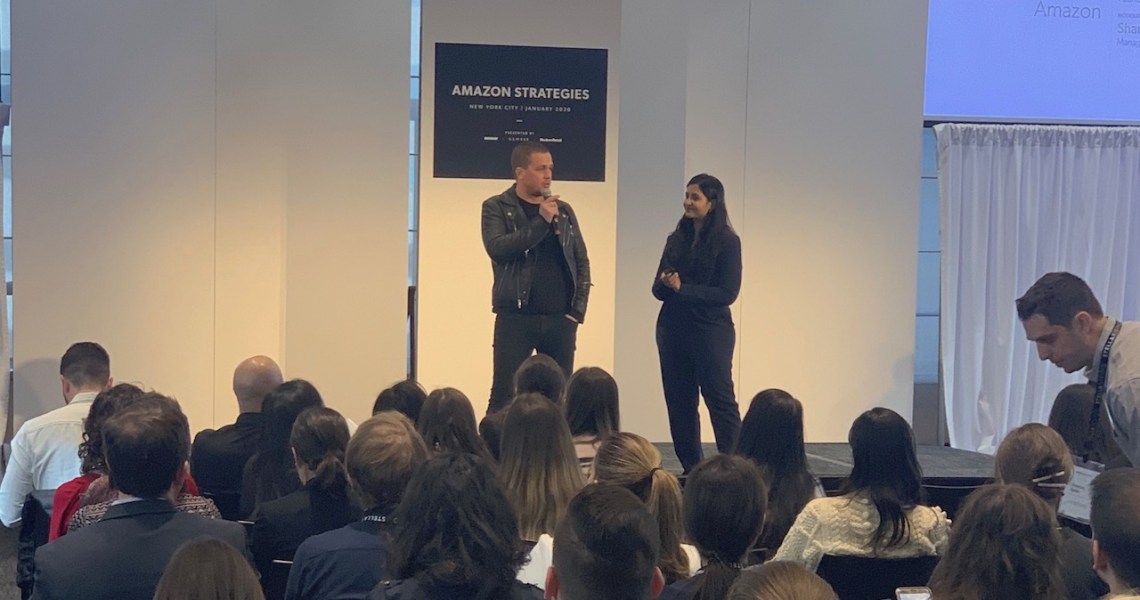For fashion and beauty retailers, Amazon presents new opportunities, if they play their cards right. At Amazon Strategies, the two-day forum presented by Glossy and sister sites Digiday and Modern Retail, companies broke down their secrets to using the juggernaut to their advantage. Below are four of the top takeaways, via slides presented by featured speakers.
Amazon can play into a strong omnichannel strategy
Rina Yashayeva, vp of strategy at media and marketing agency Stella Rising, said Amazon should be a part of every beauty brand’s omnichannel strategy. The main reason: More women (75%) are shopping for beauty products on Amazon than any other site, according to Stella Rising’s proprietary research community of 25,000 women. They listed convenience, fast shipping, wide product variety and best prices as their main reasons for choosing Amazon.
“But Amazon cannot function in a silo,” she said. “Brands need to build a holistic strategy for Amazon to be a part of. Customers are using different channels for discovery, trial, replenishment and reviews. What you do in other channels is going to impact Amazon, and vice versa.”
According to Stella Rising research, 83% of beauty shoppers take an omnichannel approach to shopping. Social media is their top source of discovery, and 58% of women look to Amazon to research products, with most going for reviews. Finally, a majority of women try out new products in-store.

Getting creative with product images can pay off
Maggie Hickey, director of strategic partnerships at marketing software company Dash Hudson, stressed that brands should “step away from the white background” and think of Amazon product images in much the same way they think of Instagram photos.
“Creative is the heartbeat of your brand,” she said. “Even on Amazon, it takes up half the page. This is an opportunity where you can really stand out and say something about yourself. Your audience on Amazon is often different than that on your social channels and website.”
She recommended leveraging existing quality content across channels, from social platforms to print ads to Amazon: “Consumers go to Amazon every day for discovery, and high-quality lifestyle imagery performs way above regular product shots.”
According to Hickey, 60% of consumers say user-generated content is the most authentic and influential form of content, and 56% of a brand’s sales lift from digital advertising is attributed to the quality of the creative.

Selling on Amazon can be a brand protection play
Emma Sayles, Amazon account manager at Moroccanoil, said the brand started selling on Amazon to gain control over its presence on the marketplace, which was formerly driven by non-approved distributors selling products, and included counterfeits and diluted products.
“The average consumer is not going to understand that this is not your brand,” she said, of the unauthorized products. “It harms your brand identity and the story you want to be out there.”
Sayles said she set out to provide a luxury, elevated experience on Amazon, within Amazon’s parameters. For Moroccanoil, in addition to updating each product page with features including five images and a video, that meant launching a brand page. Moroccanoil thinks of it as a DTC site homepage, updating it regularly and driving to it from various channels.
“The brand page is where you can really bring home that you are on Amazon — that this is not some third-party reseller that isn’t approved by the brand,” she said.
To lessen the impact of remaining obstacles, like old reviews the brand inherited, it features a diversion statement on the brand page: “We officially launched on Amazon on March 1, 2019,” it states. “Any products available before that date were unauthorized listings.”

Product title is everything
Stephanie Leffler, CEO of OneSpace, talked about how brands can optimize their presence on Amazon to improve visibility and conversion. OneSpace, which also helps brands optimize content on the e-commerce sites of retailers including Target, Walmart and CVS, has access to search data from 6 million U.S.-based shoppers, said Leffler. She added that 90% of online purchases begin with search, and on Amazon, half of a product’s organic search value is coming from its title, over its description and product detail bullets.
“Think about title before anything else,” she said, recommending that companies incorporate multiple phrases in product titles. “You’ll see compound titles in all of the top best-seller spots.”
One of her slides showed why Cetaphil should use “face wash” in its product’s title, versus its exact name, “facial cleanser.” Face wash sees 360% more searches.
“Sometimes on the brand side, we get very caught up in what we put on the package and what we think of the product as, but when we spend time looking at what the consumers call the product, they’re calling it something different,” she said. “Face wash may not seem as high-end as facial cleanser, but that is what the majority of consumers are saying when they want this product.”





